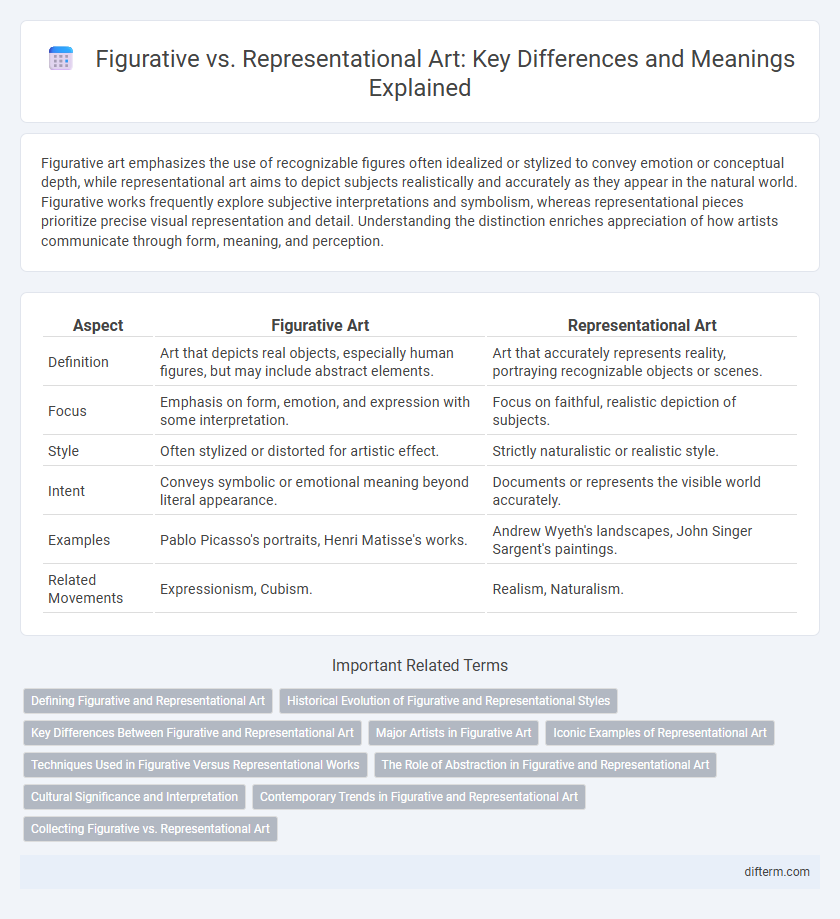Figurative art emphasizes the use of recognizable figures often idealized or stylized to convey emotion or conceptual depth, while representational art aims to depict subjects realistically and accurately as they appear in the natural world. Figurative works frequently explore subjective interpretations and symbolism, whereas representational pieces prioritize precise visual representation and detail. Understanding the distinction enriches appreciation of how artists communicate through form, meaning, and perception.
Table of Comparison
| Aspect | Figurative Art | Representational Art |
|---|---|---|
| Definition | Art that depicts real objects, especially human figures, but may include abstract elements. | Art that accurately represents reality, portraying recognizable objects or scenes. |
| Focus | Emphasis on form, emotion, and expression with some interpretation. | Focus on faithful, realistic depiction of subjects. |
| Style | Often stylized or distorted for artistic effect. | Strictly naturalistic or realistic style. |
| Intent | Conveys symbolic or emotional meaning beyond literal appearance. | Documents or represents the visible world accurately. |
| Examples | Pablo Picasso's portraits, Henri Matisse's works. | Andrew Wyeth's landscapes, John Singer Sargent's paintings. |
| Related Movements | Expressionism, Cubism. | Realism, Naturalism. |
Defining Figurative and Representational Art
Figurative art depicts recognizable subjects from the real world, emphasizing clarity in form and human figures, while representational art broadly includes any artwork that portrays objects or scenes in a way that is identifiable. Figurative art is a subset of representational art, often focusing more specifically on human figures and narrative content. Both styles contrast with abstract art by maintaining a clear connection to observable reality.
Historical Evolution of Figurative and Representational Styles
Figurative and representational art have evolved significantly since the Paleolithic era, where early humans depicted animals and hunting scenes with great symbolic meaning. During the Renaissance, artists emphasized accurate human anatomy and perspective, refining representational techniques to capture reality more precisely. The 20th century introduced abstraction, challenging traditional figurative norms and expanding interpretive possibilities in visual expression.
Key Differences Between Figurative and Representational Art
Figurative art emphasizes the human form as its primary subject, often conveying emotional or symbolic meaning beyond literal representation. Representational art, by contrast, seeks to depict objects and scenes as they appear in reality, focusing on accurate and detailed portrayals. Key differences include the level of abstraction and the artist's intent to either evoke interpretation or present clear visual references.
Major Artists in Figurative Art
Major artists in figurative art such as Lucian Freud, Alice Neel, and Francis Bacon emphasize the human form with expressive distortion and psychological depth. Figurative art, unlike pure representational art, often conveys emotional or conceptual layers beyond realistic depiction. These artists challenge traditional realism by blending abstraction and figuration to explore identity and human experience.
Iconic Examples of Representational Art
Iconic examples of representational art include Leonardo da Vinci's "Mona Lisa," which captures realistic human expression and anatomy, and Johannes Vermeer's "Girl with a Pearl Earring," noted for its lifelike detail and use of light. Representational art faithfully depicts recognizable subjects, emphasizing accurate portrayal of objects, people, or scenes from reality. These works contrast with figurative art that may incorporate abstract or distorted elements while still referencing the human form.
Techniques Used in Figurative Versus Representational Works
Figurative art techniques emphasize expressive distortion, exaggerated forms, and symbolic color to convey emotional or conceptual depth. Representational art relies on precise shading, accurate perspective, and detailed anatomy to faithfully depict visual reality. Artists in figurative art often experiment with abstraction, while representational artists focus on technical accuracy and lifelike detail.
The Role of Abstraction in Figurative and Representational Art
Abstraction in figurative and representational art transforms realistic depictions into expressive forms, emphasizing emotional impact over exact likeness. This approach allows artists to convey deeper meanings and subjective experiences while maintaining identifiable figures or scenes. The balance between abstraction and representation defines the artwork's ability to communicate both tangible and intangible aspects of reality.
Cultural Significance and Interpretation
Figurative art, characterized by its expressive and symbolic depiction of human figures and subjects, often serves as a vessel for cultural narratives and collective identity, allowing interpretations that vary across different societies. Representational art emphasizes accurate, realistic portrayals of the physical world, providing a more direct and accessible reflection of cultural and historical contexts. Both styles influence cultural significance by shaping how viewers perceive and connect with heritage, memory, and social values through visual language.
Contemporary Trends in Figurative and Representational Art
Contemporary trends in figurative and representational art emphasize a blend of traditional techniques with innovative mediums, reflecting a diverse range of social and cultural narratives. Artists increasingly explore identity, politics, and technology through figurative forms, challenging classical realism while maintaining recognizable imagery. This evolution highlights a dynamic dialogue between abstraction and representation, expanding the boundaries of visual storytelling in modern art.
Collecting Figurative vs. Representational Art
Collecting figurative art emphasizes the depiction of human forms and emotions, often capturing narrative depth and expressive detail that appeal to personal connection and storytelling. Representational art broadens the scope to include realistic portrayals of objects, landscapes, and scenes, prioritizing accuracy and recognizable subject matter. Understanding the nuances between figurative and representational art helps collectors curate diverse collections that reflect both emotional resonance and visual realism.
figurative vs representational Infographic

 difterm.com
difterm.com